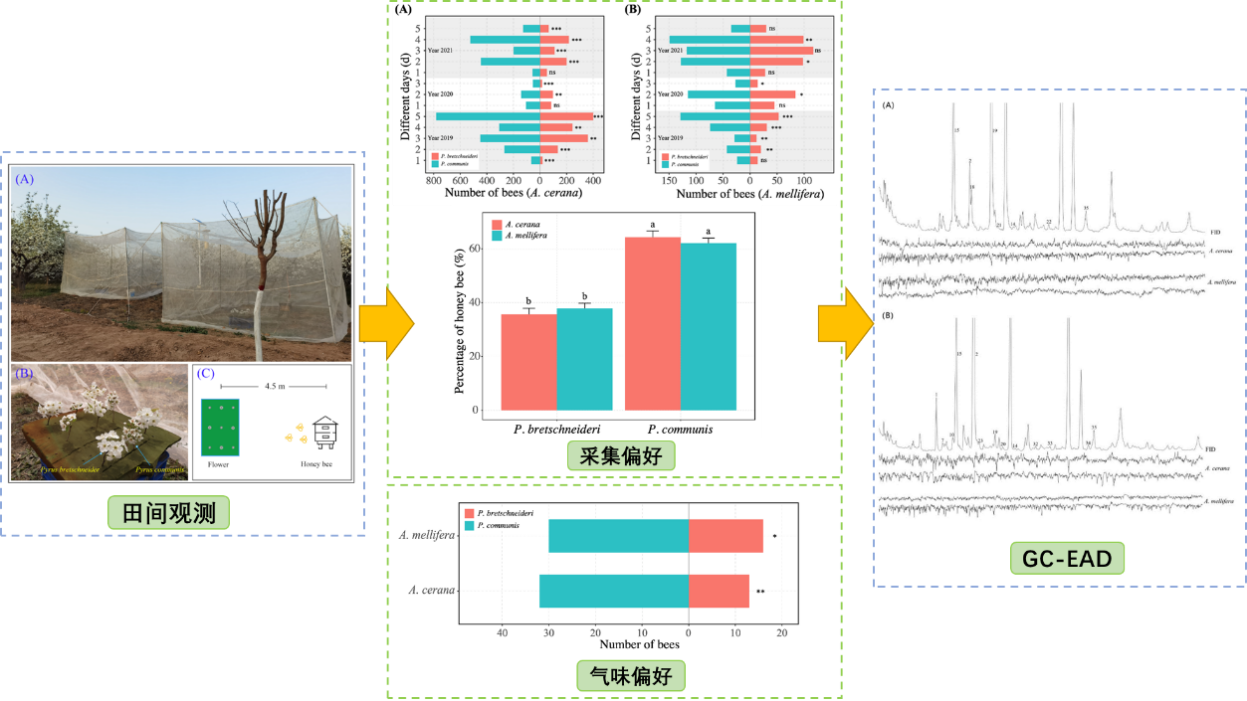Significant Effect of Volatile Odor of Pear Blossoms on Honey Bee’s Decision in Collecting Honey
Date:2022-08-31
Institute of Apicultural Research of Chinese Academy of Agricultural Sciences studied the relations between honey bees and pear blossoms to reveal the differences in behaviors between Apis cerana cerana and Apis mellifera. Relevant findings were published in Agriculture.

Field observation |
Pollen collection preference |
Odor preference |
China boasts the most abundant pear germplasm resources and the highest pear yield in the world. As a self-incompatible crop, pear trees bear fruits with the help of pollinators. However, pear blossoms are not highly attractive to honey bees and other major pollinating insects. This experiment explored the differences between Apis cerana cerana and Apis mellifera in visiting Pyrus bretschneideri blossoms and Pyrus communis Linn. blossoms through behavioral observation and electrophysiological techniques, studied the effect of volatile odor of pear blossoms on the two types of honey bee’s decision in collecting honey, and further identified the electrophysiologically active compounds that can cause the electroantennogram response of honey bees.
According to field vs. indoor behavioral observation experiments, both types of honey bees preferred to visit Pyrus communis Linn. blossoms (P<0.05), indicating that the volatile compounds of pear blossoms were essential for attracting honey bees. We detected 27 and 31 compounds in volatiles of Pyrus communis Linn. Blossoms and Pyrus bretschneideri blossoms, respectively, of which 17 compounds were common to both types of pear blossoms. Based on GC-EAD, a total of 16 volatiles of pear blossoms were able to evoke the electroantennogram response in honey bees; Apis cerana cerana responded to 15 of the compounds, while Apis mellifera responded to only seven compounds. Among the electrophysiologically active compounds, five compounds (1-nonylalcohol, linalool, methyl 2-hydroxy-3-methylpentanoate, Methyl L-isoleucinate and α-farnesene) were common to both types of pear blossoms. In addition, eight compounds (L-valine methyl ester, benzaldehyde, 6-methyl-5-hepten-2-one, isoflurone, 2-methyloctane, polycyclic ene, longifolene and caryophyllene) in volatiles of Pyrus communis Linn. Blossoms showed the electrophysiological activity on honey bee antennae, while three electrophysiologically active compounds (β-ocimene, 4-Ketoisophorone and syringol D) were found in volatiles of Pyrus communis Linn. blossoms. This study provided basis for honey bees’ choice of pear trees in pollination, and demonstrated that volatiles of pear blossoms have a significant effect on honey bees’ flower-visiting decisions.
Link: https://www.mdpi.com/2077-0472/12/8/1074